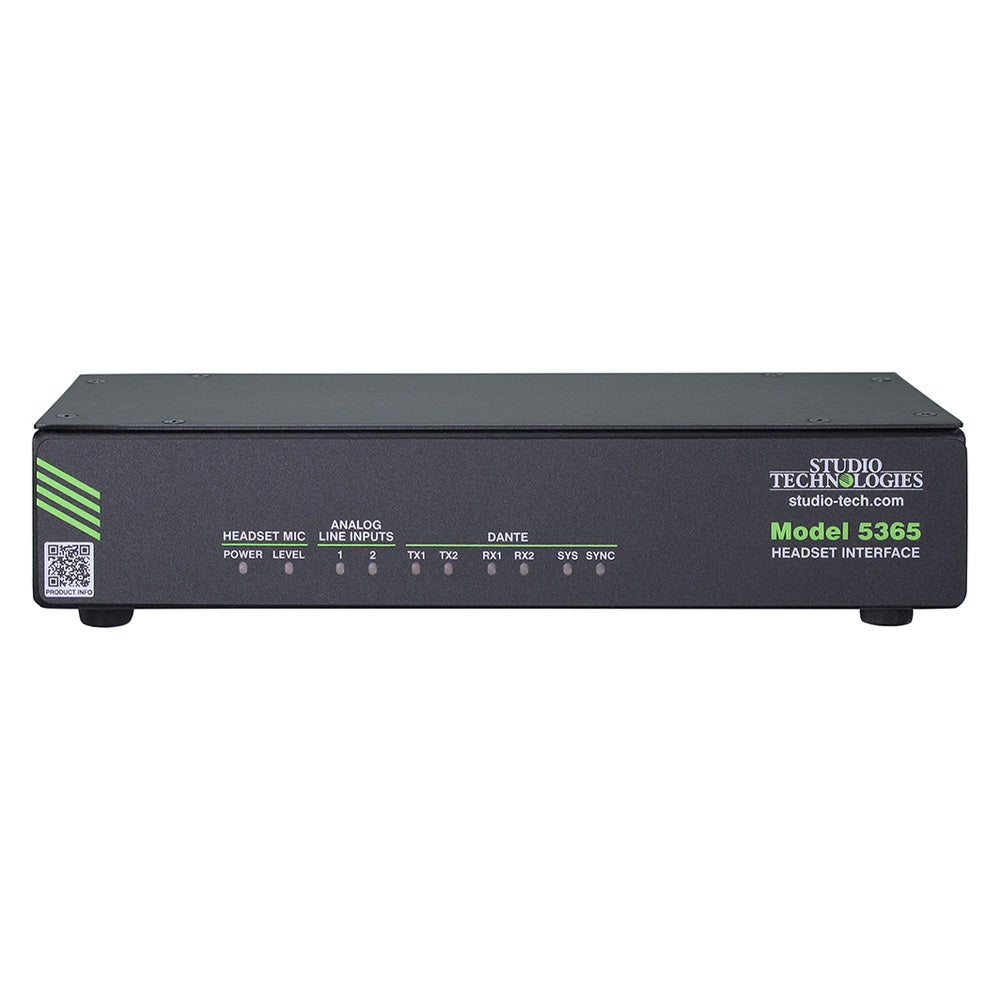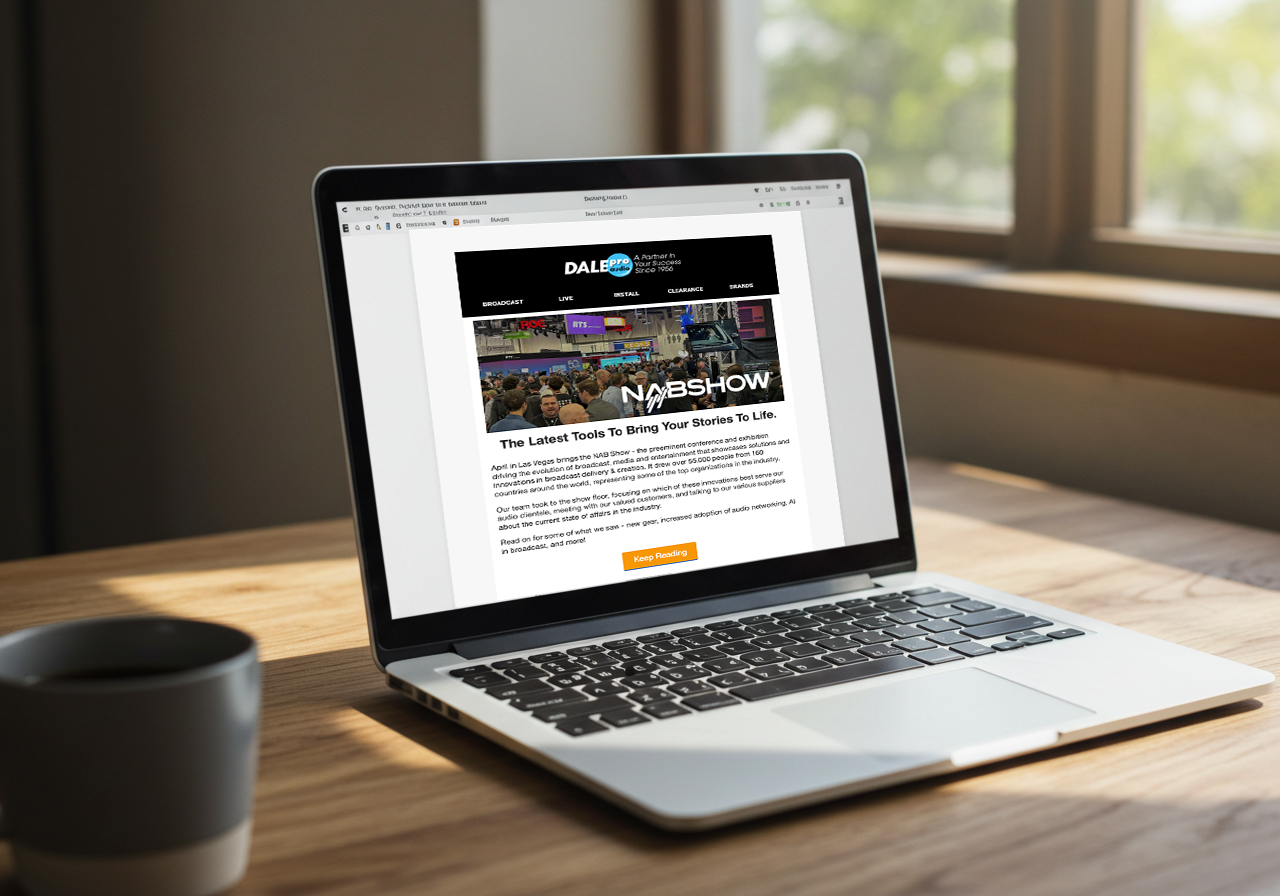

Studio Technologies Model 5365 - Dante to IFB / Intercom Headset Interface
Availability:
Special Order ItemThis item is not stocked and needs to be ordered from the manufacturer. Please contact our sales team for more information.

Description
The Model 5365 provides a 5-pin female XLR connector that interfaces with an intercom or broadcast-style headset. Some applications may connect the Model 5365's headset connector to a separate headset interface assembly. The headset will incorporate both a microphone and headphones. The latter will provide either a dual-ear or single-ear headphone with dual-channel (stereo) or single-channel (monaural) audio performance. The headset connector is located on the front panel for easy access by the user. Refer to Figure 4 for headset connection details. The microphone input connections are compatible with most unbalanced or electret (low-voltage DC- powered) microphones. A balanced dynamic microphone should, in most cases, also function correctly if the signal – (low) is connected to Model 5365's mic in –/shield connection. No support is provided for microphones that require P12 or P48 phantom power.
Audio Routing
The two Dante receiver (input) channels associated with the Model 5365 need to be routed (connected) to Dante transmitter (output) channels on associated equipment. Configuration settings allow these two audio sources to ultimately be sent to the Model 5365's 2-channel headphone output. The Model 5365's two Dante transmitter (output) channels must be assigned to Dante receiver (input) channels on associated equipment. This achieves routing the Model 5365's two talk output audio channels to the device (or devices) that will be "listening" to them. Within Dante Controller a "subscription" is the term used for routing a transmitter channel or flow (a group of up to four output channels) to a receiver channel or f low (a group of up to four input channels). The number of transmitter flows associated with an UltimoX2 integrated circuit is limited to two. These can either be unicast, multicast, or a combination of the two. If the Model 5365's transmitter (output) channels need to be routed using more than two flows it's possible that an intermediary device, such as the Studio Technologies' Model 5421 or Model 5422A Dante Intercom Audio Engine, can be used to "repeat" the signals.
Ethernet Connection with PoE
A 100BASE-TX Ethernet connection that supports Power-over-Ethernet (PoE) is required for Model 5365 operation. This one connection will provide both the Ethernet data interface and power for the Model 5365's circuitry. A 10BASE-T connection is not sufficient and a 1000BASE-T (GigE) connection is not supported unless it can automatically "fall back" to 100BASE-TX operation. The Model 5365 supports Ethernet switch power management, enumerating itself as a PoE class 1 device. Any source that is compliant with the IEEE® 802.3af standard will function correctly. Should the selected Ethernet switch port support Energy-Efficient Ethernet (EEE) it must be disabled to help ensure reliable Dante operation. The Ethernet connection is made by way of an RJ45 jack that is located on the Model 5365's back panel. This allows connection by way of a RJ45 plug that's part of a typical Ethernet "patch cable." A crossover cable will never be required as the Model 5365's Ethernet interface supports auto MDI/MDI-X. The maximum cable distance is 100-meters (325-feet) for twisted-pair Ethernet cabling.
Stereo Line Input
A 3-conductor 3.5 mm jack is located on the Model 5365's back panel and provides access to the unit's stereo (2-channel) analog line-level audio input. This allows direct interfacing with a source of unbalanced stereo analog audio, typically provided by a personal computer's line output. The nominal input level is –10 dBu. The interconnecting cable's 3-conductor 3.5mm plug should be wired such that left channel audio is on the tip lead, right channel audio is on the ring lead, and audio shield/common is on the sleeve lead. Refer to Figure 2 for connection details. Configuration choices in the STcontroller application allow the sensitivity of the two input circuits to be individually adjusted. This allows compatibility with signal sources that have a nominal level that is significantly lower than the unit's nominal –10 dBu.
| Power Source | Power-over-Ethernet (PoE): class 1 (low power, ²3.84 watts) per IEEE¨ 802.3af |
| Network Interface | Type: 100BASE-TX, Fast Ethernet per IEEE 802.3u (10BASE-T and 1000BASE-T (GigE) not supported) Power-over-Ethernet (PoE): Per IEEE 802.3af Data Rate: 100 Mb/s (10 Mb/s and 1000 Mb/s not supported) |
| Network Audio Technology | Type: Dante audio-over-Ethernet AES67-2018 Support: Yes Dante Domain Manager (DDM) Support: Yes Bit Depth: up to 24 Sample Rate: 48 kHz Pull-Up/Down Support: No Dante Transmitter (Output) Channels: 2 Dante Receiver (Input) Channels: 2 Dante Audio Flows: 4; 2 transmitter, 2 receiver Transmitter (Output) and Receiver (Input) Nominal Level: Ð20 dBFS |
| Microphone Input | Compatibility: analog dynamic or electret microphones Type: unbalanced Electret Microphone Power: 8.5 volts DC via 1 k (1000) ohms series resistance, selectable on/off Gain: 18, 24, 30, 36, or 42 dB, selectable Frequency Response: 40 Hz to 20 kHz, Ð3 dB, nominal Distortion (THD+N): <0.03%, 1 kHz, 24 dB gain Noise Floor: Ð96 dBFS, A-weighted, electret power off |
| Compressor | Threshold: 1.5 dB above nominal level (Ð18.5 dBFS) Slope: 2:1 |
| Headphone Output | Type: 2-channel Compatibility: intended for connection to stereo (dual-channel) or monaural (single-channel) headsets with nominal impedance of 50 ohms or greater Maximum Output Voltage: 2.6 Vrms, ref 1 kHz and 150 ohms load Frequency Response: 10 Hz to 20 kHz, Ð2 dB Distortion (THD+N): <0.04%, ref 1 kHz and +10 dBu output Dynamic Range:>85 dB |
| Analog Line Inputs | Number of Channels: 2 Type: unbalanced, capacitor coupled Impedance: 12.5 k ohms Nominal Level: Ð10 dBu Dynamic Range: 98 dB, A-weighted Distortion (THD+N): <0.008%, ref 1 kHz and +13 dBu input Frequency Response: +0/-2 dB, 20 Hz to 20 kHz |
| Analog Line Outputs | Number of Channels: 2 Type: unbalanced Source Impedance: 50 ohms Nominal Level: Ð13 dBu Dynamic Range: 94 dB, A-weighted Distortion (THD+N): <0.04%, ref 1 kHz and +9 dBu output Frequency Response: ±0.7 dB, 10 Hz to 20 kHz |
| Identification Tone Output | Destination: headphone output channels Type: 500 Hz, sine-wave Duration: sequence of six tone "bursts" over six seconds (500 mSec On/500 mSec Off) Nominal Level: Ð13 dBu Enable Signal: Dante identification command |
| Connectors | Ethernet: RJ45 jack Headset: 5-pin female XLR Analog Line Inputs: 3-conductor (TRS) 3.5 mm jack Analog Line Outputs: 3-conductor (TRS) 3.5 mm jack USB: type A receptacle (used only for updating application firmware) |
| Configuration | requires Studio Technologies' STcontroller for Windows software application |
| Software Updating | USB flash drive used for updating application firmware; Dante Updater application for updating Dante interface firmware |
| Environmental | Operating Temperature: 0 to 50 degrees C (32 to 122 degrees F) Storage Temperature: Ð40 to 70 degrees C (Ð40 to 158 degrees F) Humidity: 0 to 95%, non-condensing Altitude: not characterized |
| Dimensions (Overall) | 8.7 inches wide (22.1 cm) 1.72 inches high (4.4 cm) 4.2 inches deep (10.7 cm) (includes XLR5F latch) |
| Weight | 0.95 pounds (0.42 kg); rack-mounting installation kits add approximately 0.2 pounds (0.09 kg) |
| Deployment | Intended for tabletop applications. Four optional mounting kits are also available: RMBK-10 allows one unit to be mounted in a panel cutout or on a flat surface RMBK-11 allows one unit to be mounted in the left- or right-side of one space (1U) of a standard 19-inch rack RMBK-12 allows two units to be mounted in one space (1U) of a standard 19-inch rack RMBK-13 allows one unit to be mounted in the center of one space (1U) of a standard 19-inch rack |
The Model 5365 provides a 5-pin female XLR connector that interfaces with an intercom or broadcast-style headset. Some applications may connect the Model 5365's headset connector to a separate headset interface assembly. The headset will incorporate both a microphone and headphones. The latter will provide either a dual-ear or single-ear headphone with dual-channel (stereo) or single-channel (monaural) audio performance. The headset connector is located on the front panel for easy access by the user. Refer to Figure 4 for headset connection details. The microphone input connections are compatible with most unbalanced or electret (low-voltage DC- powered) microphones. A balanced dynamic microphone should, in most cases, also function correctly if the signal – (low) is connected to Model 5365's mic in –/shield connection. No support is provided for microphones that require P12 or P48 phantom power.
Audio Routing
The two Dante receiver (input) channels associated with the Model 5365 need to be routed (connected) to Dante transmitter (output) channels on associated equipment. Configuration settings allow these two audio sources to ultimately be sent to the Model 5365's 2-channel headphone output. The Model 5365's two Dante transmitter (output) channels must be assigned to Dante receiver (input) channels on associated equipment. This achieves routing the Model 5365's two talk output audio channels to the device (or devices) that will be "listening" to them. Within Dante Controller a "subscription" is the term used for routing a transmitter channel or flow (a group of up to four output channels) to a receiver channel or f low (a group of up to four input channels). The number of transmitter flows associated with an UltimoX2 integrated circuit is limited to two. These can either be unicast, multicast, or a combination of the two. If the Model 5365's transmitter (output) channels need to be routed using more than two flows it's possible that an intermediary device, such as the Studio Technologies' Model 5421 or Model 5422A Dante Intercom Audio Engine, can be used to "repeat" the signals.
Ethernet Connection with PoE
A 100BASE-TX Ethernet connection that supports Power-over-Ethernet (PoE) is required for Model 5365 operation. This one connection will provide both the Ethernet data interface and power for the Model 5365's circuitry. A 10BASE-T connection is not sufficient and a 1000BASE-T (GigE) connection is not supported unless it can automatically "fall back" to 100BASE-TX operation. The Model 5365 supports Ethernet switch power management, enumerating itself as a PoE class 1 device. Any source that is compliant with the IEEE® 802.3af standard will function correctly. Should the selected Ethernet switch port support Energy-Efficient Ethernet (EEE) it must be disabled to help ensure reliable Dante operation. The Ethernet connection is made by way of an RJ45 jack that is located on the Model 5365's back panel. This allows connection by way of a RJ45 plug that's part of a typical Ethernet "patch cable." A crossover cable will never be required as the Model 5365's Ethernet interface supports auto MDI/MDI-X. The maximum cable distance is 100-meters (325-feet) for twisted-pair Ethernet cabling.
Stereo Line Input
A 3-conductor 3.5 mm jack is located on the Model 5365's back panel and provides access to the unit's stereo (2-channel) analog line-level audio input. This allows direct interfacing with a source of unbalanced stereo analog audio, typically provided by a personal computer's line output. The nominal input level is –10 dBu. The interconnecting cable's 3-conductor 3.5mm plug should be wired such that left channel audio is on the tip lead, right channel audio is on the ring lead, and audio shield/common is on the sleeve lead. Refer to Figure 2 for connection details. Configuration choices in the STcontroller application allow the sensitivity of the two input circuits to be individually adjusted. This allows compatibility with signal sources that have a nominal level that is significantly lower than the unit's nominal –10 dBu.
| Power Source | Power-over-Ethernet (PoE): class 1 (low power, ²3.84 watts) per IEEE¨ 802.3af |
| Network Interface | Type: 100BASE-TX, Fast Ethernet per IEEE 802.3u (10BASE-T and 1000BASE-T (GigE) not supported) Power-over-Ethernet (PoE): Per IEEE 802.3af Data Rate: 100 Mb/s (10 Mb/s and 1000 Mb/s not supported) |
| Network Audio Technology | Type: Dante audio-over-Ethernet AES67-2018 Support: Yes Dante Domain Manager (DDM) Support: Yes Bit Depth: up to 24 Sample Rate: 48 kHz Pull-Up/Down Support: No Dante Transmitter (Output) Channels: 2 Dante Receiver (Input) Channels: 2 Dante Audio Flows: 4; 2 transmitter, 2 receiver Transmitter (Output) and Receiver (Input) Nominal Level: Ð20 dBFS |
| Microphone Input | Compatibility: analog dynamic or electret microphones Type: unbalanced Electret Microphone Power: 8.5 volts DC via 1 k (1000) ohms series resistance, selectable on/off Gain: 18, 24, 30, 36, or 42 dB, selectable Frequency Response: 40 Hz to 20 kHz, Ð3 dB, nominal Distortion (THD+N): <0.03%, 1 kHz, 24 dB gain Noise Floor: Ð96 dBFS, A-weighted, electret power off |
| Compressor | Threshold: 1.5 dB above nominal level (Ð18.5 dBFS) Slope: 2:1 |
| Headphone Output | Type: 2-channel Compatibility: intended for connection to stereo (dual-channel) or monaural (single-channel) headsets with nominal impedance of 50 ohms or greater Maximum Output Voltage: 2.6 Vrms, ref 1 kHz and 150 ohms load Frequency Response: 10 Hz to 20 kHz, Ð2 dB Distortion (THD+N): <0.04%, ref 1 kHz and +10 dBu output Dynamic Range:>85 dB |
| Analog Line Inputs | Number of Channels: 2 Type: unbalanced, capacitor coupled Impedance: 12.5 k ohms Nominal Level: Ð10 dBu Dynamic Range: 98 dB, A-weighted Distortion (THD+N): <0.008%, ref 1 kHz and +13 dBu input Frequency Response: +0/-2 dB, 20 Hz to 20 kHz |
| Analog Line Outputs | Number of Channels: 2 Type: unbalanced Source Impedance: 50 ohms Nominal Level: Ð13 dBu Dynamic Range: 94 dB, A-weighted Distortion (THD+N): <0.04%, ref 1 kHz and +9 dBu output Frequency Response: ±0.7 dB, 10 Hz to 20 kHz |
| Identification Tone Output | Destination: headphone output channels Type: 500 Hz, sine-wave Duration: sequence of six tone "bursts" over six seconds (500 mSec On/500 mSec Off) Nominal Level: Ð13 dBu Enable Signal: Dante identification command |
| Connectors | Ethernet: RJ45 jack Headset: 5-pin female XLR Analog Line Inputs: 3-conductor (TRS) 3.5 mm jack Analog Line Outputs: 3-conductor (TRS) 3.5 mm jack USB: type A receptacle (used only for updating application firmware) |
| Configuration | requires Studio Technologies' STcontroller for Windows software application |
| Software Updating | USB flash drive used for updating application firmware; Dante Updater application for updating Dante interface firmware |
| Environmental | Operating Temperature: 0 to 50 degrees C (32 to 122 degrees F) Storage Temperature: Ð40 to 70 degrees C (Ð40 to 158 degrees F) Humidity: 0 to 95%, non-condensing Altitude: not characterized |
| Dimensions (Overall) | 8.7 inches wide (22.1 cm) 1.72 inches high (4.4 cm) 4.2 inches deep (10.7 cm) (includes XLR5F latch) |
| Weight | 0.95 pounds (0.42 kg); rack-mounting installation kits add approximately 0.2 pounds (0.09 kg) |
| Deployment | Intended for tabletop applications. Four optional mounting kits are also available: RMBK-10 allows one unit to be mounted in a panel cutout or on a flat surface RMBK-11 allows one unit to be mounted in the left- or right-side of one space (1U) of a standard 19-inch rack RMBK-12 allows two units to be mounted in one space (1U) of a standard 19-inch rack RMBK-13 allows one unit to be mounted in the center of one space (1U) of a standard 19-inch rack |
Your home for all things pro audio—backed by expertise and experience. Connect with us today.
Your home for all things pro audio—backed by expertise and experience. Connect with us today.

